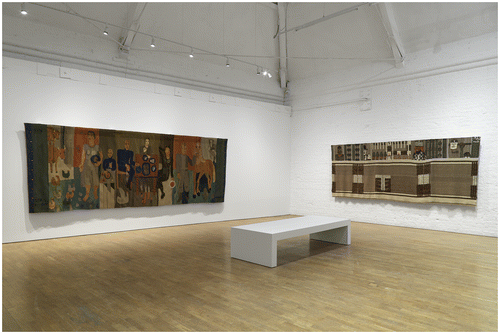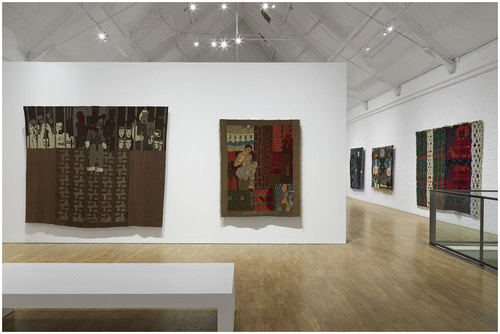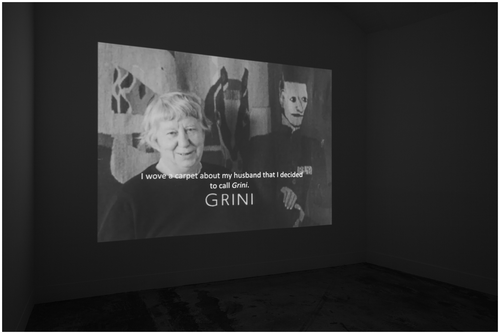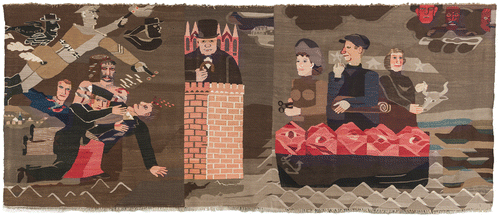Hannah Ryggen (1894–1970) enjoyed acclaim during her lifetime. Major exhibitions in the 1950s and 1960s included the honor of representing Norway at the Venice Biennale of 1964. But her name remained far more familiar within Scandinavia than beyond until 2012 when her work was included in dOCUMENTA 13 in Kassel, Germany. Modern Art Oxford’s recent retrospective of 16 tapestries, organized in partnership with Nordenfjeldske Kunstindustrimuseum and the Museene I Sør Trøndelag, was the first comprehensive exhibition to visit Britain.
Ryggen was born in the southern Swedish city of Malmö and lived with her husband, the Norwegian painter Hans Ryggen, on an isolated smallholding in Ørlandet, north of the city of Trondheim on the west coast of Norway. The region they called home would be of strategic importance during Nazi occupation of the country during World War II. Sweden remained neutral during the war and this fact, coupled with Hans Ryggen’s incarceration by the Nazi forces (depicted in the tapestry Grini from 1945) (Fig. 3), may explain why Hannah Ryggen is often identified as a Norwegian artist. Towards the end of her career, Ryggen cemented her connection to the region when she donated a significant number of her tapestries, which she wanted to see housed in a public rather than private collection (Exhibition notes, n.pag), to the National Museum of Decorative Arts and Design (NKIM) in Trondheim in exchange for a monthly stipend.
While Ryggen lived and worked in physical isolation, she made utterly contemporary work about political events both near and far from home. A committed Communist, she stated in 1942 that, “every man and woman, whether rich or poor, ought to be raised capable of two things: producing their own food and supporting themselves. It is an indignity that some serve others. Everyone should work, no one should be above another” (Exhibition notes, n.pag). Ryggen’s commitment to self-reliance is also apparent in her material choices, with the stunning color palette of her tapestries often drawn from the plant dyes she collected in her immediate landscape. For some colors she used urine as a mordant, collected by request from male visitors (gender effects the chemistry of the dye bath) to her home.
The family received Dagbladet for more than three decades, a publication that was the source of much of their knowledge of world news. Early works such as Ethiopia (1935) (Fig. 4) depicted the Italian invasion of North Africa, presumably based on information she read in the publication. When exhibited at the Paris World Fair in 1937, the top left section showing Mussolini’s head speared by an Ethiopian soldier was folded over (exhibition wall text); at the 1939 New York World Fair the imagery was concealed under a white cloth (5.23–6.02 Hannah Ryggen bildväverska)—censorship which arguably drew attention to rather than away from the content of the work. In the decade that followed, Ryggen also wove atrocities closer to home. 6 October 1942 (1943) records the execution of Trondheim theater director Henry Gleditsch during the Nazi occupation. Marta Kuzma (2012, 6), in her text for the dOCUEMNTA 13, notes that, “During the interwar period, Ryggen set out to produce a body of work that challenged the prevailing sense of apathy, as well as the prevailing codes of legibility and legitimacy.”
Ryggen initially studied painting and was a self-trained weaver. She planned each work at her loom rather than working from cartoons or drawings. It may be this approach that is responsible for the feeling of spontaneity in many of her tapestries, which “suggest a lack of composition and even a lack of skill and ease” (Kazuma 2012, 6). With the rising extremism of politics in Europe and the United States today, it is useful to be reminded of the significant political commitment Ryggen made through her chosen medium of tapestry between the early 1930s when her first mature work is credited, to her final large tapestry Blood in the Grass (1966) about the Vietnam War. Ryggen was not a character to be cowed in her life or work. In a gesture reminiscent of the Chilean arpilleras which depict the disappeared of General Pinochet’s brutal dictatorship of Chile (1973–1990), Kuzma (2012, 5) recounts that Ryggen is thought have “flagrantly hung the more visually condemning tapestries on her clothesline outside her house, in full view of passing Nazi soldiers but without their noticing it.”
Figure 1 Hannah Ryggen: Woven Histories exhibition installation Modern Art Oxford, 2018.

Figure 2 Hannah Ryggen: Woven Histories exhibition installation Modern Art Oxford, 2018.

Figure 3 Hannah Ryggen: Woven Histories exhibition installation Modern Art Oxford, 2018.

Additional information
Notes on contributors
Jessica Hemmings
Jessica Hemmings is Professor of Crafts at the University of Gothenburg, Sweden.
References
- Hanna Ryggen: Woven Histories . Exhibition Notes (2018) Modern Art Oxford.
- Hanna Ryggen bildväverska video accessed https://www.youtube.com/watch?v=MuvrmPvsBBM March 11, 2018.
- Kuzma, M. (2012) 100 Notes – 100 Thoughts Nº 067 Hannah Ryggen (Kassel: documenta and Museum Fridericianum).


